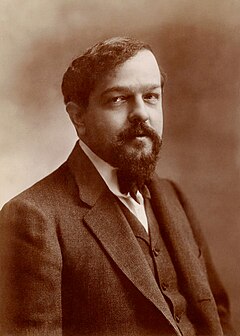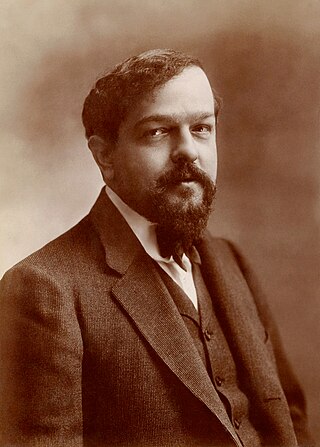
(Achille) Claude Debussy was a French composer. He is sometimes seen as the first Impressionist composer, although he vigorously rejected the term. He was among the most influential composers of the late 19th and early 20th centuries.

Eric Alfred Leslie Satie, who signed his name Erik Satie after 1884, was a French composer and pianist. He was the son of a French father and a British mother. He studied at the Paris Conservatoire, but was an undistinguished student and obtained no diploma. In the 1880s he worked as a pianist in café-cabaret in Montmartre, Paris, and began composing works, mostly for solo piano, such as his Gymnopédies and Gnossiennes. He also wrote music for a Rosicrucian sect to which he was briefly attached.
Impressionism in music was a movement among various composers in Western classical music whose music focuses on mood and atmosphere, "conveying the moods and emotions aroused by the subject rather than a detailed tone‐picture". "Impressionism" is a philosophical and aesthetic term borrowed from late 19th-century French painting after Monet's Impression, Sunrise. Composers were labeled Impressionists by analogy to the Impressionist painters who use starkly contrasting colors, effect of light on an object, blurry foreground and background, flattening perspective, etc. to make the observer focus their attention on the overall impression.
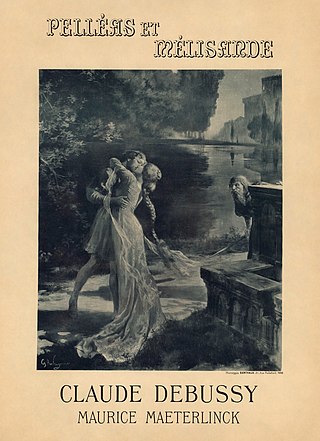
Pelléas et Mélisande is an opera in five acts with music by Claude Debussy. The French libretto was adapted from Maurice Maeterlinck's symbolist play of the same name. It premiered at the Salle Favart in Paris by the Opéra-Comique on 30 April 1902; Jean Périer was Pelléas and Mary Garden was Mélisande, conducted by André Messager, who was instrumental in getting the Opéra-Comique to stage the work. The only opera Debussy ever completed, it is considered a landmark in 20th-century music.

André Caplet was a French composer and conductor of classical music. He was a friend of Claude Debussy and completed the orchestration of several of Debussy's compositions as well as arrangements of several of them for different instruments.

Charles-Louis-Eugène Koechlin, commonly known as Charles Koechlin, was a French composer, teacher and musicologist. Among his better known works is Les Heures persanes, a set of piano pieces based on the novel Vers Ispahan by Pierre Loti and The Seven Stars Symphony, a 7 movement symphony where each movement is themed around a different film star who were popular at the time of the piece's writing (1933).

La mer, trois esquisses symphoniques pour orchestre, or simply La mer, L. 109, CD. 111, is an orchestral composition by the French composer Claude Debussy.

Nocturnes, L 98 is an impressionist orchestral composition in three movements by the French composer Claude Debussy, who wrote it between 1892 and 1899. It is based on poems from Poèmes anciens et romanesques.

Jeux (Games) is a ballet written by Claude Debussy. Described as a "poème dansé", it was written for Sergei Diaghilev's Ballets Russes with choreography by Vaslav Nijinsky. Debussy initially objected to the scenario but reconsidered the commission when Diaghilev doubled the fee. Debussy wrote the score quickly, from mid-August to mid-September 1912. Robert Orledge has analysed the chronology of Debussy's composition and preserved manuscripts of the score.

Le Martyre de saint Sébastien is a five-act musical mystery play on the subject of Saint Sebastian, with a text written in 1911 by the Italian author Gabriele D'Annunzio and incidental music by the French composer Claude Debussy (L.124).
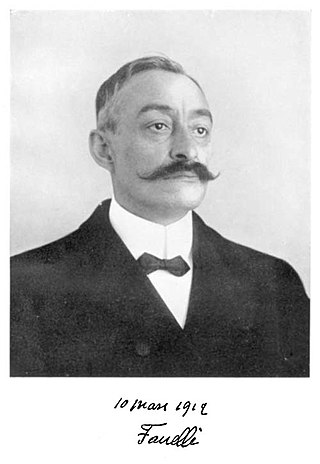
Ernest Fanelli was a French composer who is known for his works which have been considered as precursing Impressionism. He gained renown when his symphonic poem Thèbes premiered in Paris; this was a work incorporating elements associated with music ahead of its time, such as unique harmonies, extended chords, and polytonality.
Roger David Edward Nichols is an English musicologist, critic, translator and author. After an early career as a university lecturer he became a full-time freelance writer in 1980. He is particularly known for his works on French music, including books about Claude Debussy, Olivier Messiaen, Maurice Ravel, Francis Poulenc and the Parisian musical scene of the years after the First World War. Among his translations are the English versions of the standard biography of Gabriel Fauré by Jean-Michel Nectoux and of Harry Halbreich's study of Arthur Honegger.
Images is a suite of six compositions for solo piano by Claude Debussy. They were published in two books/series, each consisting of three pieces. These works are distinct from Debussy's Images pour orchestre. The first book was composed between 1901 and 1905, and the second book was composed in 1907. The total duration is approximately 30 minutes. With respect to the first series of Images, Debussy wrote to his publisher, Jacques Durand: "Without false pride, I feel that these three pieces hold together well, and that they will find their place in the literature of the piano ... to the left of Schumann, or to the right of Chopin... "

La Damoiselle élue, L. 62, is a cantata for soprano and contralto soloists, 2-part female chorus, and orchestra, composed by Claude Debussy in 1887–1888 based on a text by Dante Gabriel Rossetti. It premiered in Paris in 1893.
Marie-Jacques Massacrié-Durand was a French music publisher and composer, sometimes under the pseudonym J. Samm. The family's publishing house, Éditions Durand, published works by many of Durand's contemporaries, including Claude Debussy, Paul Dukas, Gabriel Fauré, Jacques Ibert, Darius Milhaud, Maurice Ravel and Camille Saint-Saëns.

Croquis et agaceries d'un gros bonhomme en bois, translated as Sketches and Exasperations of a Big Wooden Dummy, is a 1913 piano composition by Erik Satie. One of his pre-World War I humoristic suites, it was published by E. Demets that same year. Ricardo Viñes gave the premiere during a concert of the Société Nationale de Musique at the Salle Pleyel in Paris on March 28, 1914. A typical performance lasts about five minutes.
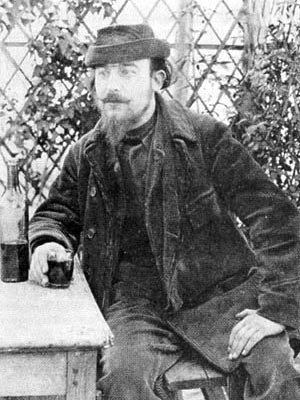
Le poisson rêveur(The Dreamy Fish) is an unfinished tone poem for solo piano composed between 1900 and 1901 by Erik Satie, based on a tale by "Lord Cheminot". The text does not survive and Satie's music went unpublished for decades. In performance the piece lasts about 6 minutes.
Williametta Spencer is an American composer, musicologist, and teacher who plays harpsichord, organ, and piano. She is best known for her award-winning choral work At the Round Earth’s Imagined Corners.

Rhapsodie for saxophone and orchestra, L.98, also known as Rhapsodie mauresque or Rhapsodie orientale, is a piece for alto saxophone and accompaniment by Claude Debussy. Completed in solo and piano form in 1911, the piece is most well known through its 1919 orchestration of the accompaniment by Jean Roger-Ducasse.
